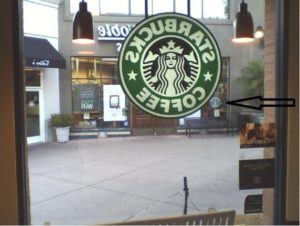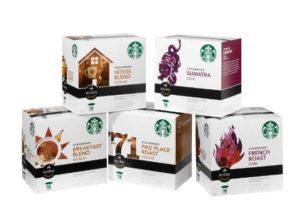Starbucks: Grinding Beans and Data

Starbucks uses data to "know" their customer; helping them decide what products to make, what promotions to do, and where to place their stores
Have you ever wondered why Starbucks places its locations in such close proximity? Have you ever seen something like the picture below in which two Starbucks locations are a mere hundred feet apart?
Although location strategy such as this may seem insane, Starbucks has been using Atlas, a geographic information system created by Esri, to determine their future store locations and overall growth strategy1. Using this application, Starbucks can map out local trade areas, retail clusters, area demographics, traffic patterns, transportation nodes, and where new offices are being built (generally leading to a possible increase in customer base). Atlas can also be used to analyze where customers tend to spend a higher average amount of money for products, allowing Starbucks to target more expensive products such as their Clover Brewing System—a smoother premium coffee that demands a higher price2.
Starbucks also uses data to understand their customer product needs. Using in-store sales data and interviews with baristas, Starbucks has been able launch their K-Cup products in groceries stores. The data allows them to see which in-store products are the most popular in given areas to stock grocery stores appropriately with matching K-Cup products. They can also hone in on specific details for each product; for example, Starbucks determined that 43% of tea drinkers do not add sugar to their order, so they created a line of unsweetened tea K-Cups. This recent move into K-Cups has been a great marketing tool; allowing Starbucks to “come home” with the consumer by deterring customers from purchasing other grocery brands. Starbucks is not scared of cannibalizing their in-store revenues as most customers will still need to go to the store to get specialty drinks3.
Starbucks uses its loyalty cards to track specific individual buying data. The company has approximately 6 million people in their loyalty card program; of which, they have currently made individual profiles for half. These profiles allow Starbucks to see which products are selling to which individual customer demographics. It also allows the company to analyze purchasing trends and timelines to send mobile coupons and promotions when needed; generally targeting discounts towards customers who are showing tendencies of not repurchasing at Starbucks4.
Starbucks is also generating interesting regional and time based promotions. They have been able to analyze areas with high concentrations of smart phones to release mass-quantity app-based discounts. They have also used weather pattern data to create Frappuccino promotions that coincide with oncoming heatwaves5.
Overall, Starbucks main objective is to deliver quality products to the most consumers possible. Using “big data” has allowed them to strategically grow their brick-and-mortar and product offerings to satisfy their caffeine craving customers. Although they have done some interesting work, I think there is a lot more data that can be analyzed in the future. Patrick O’Hagan, director of market planning at Starbucks, has stated that the company is in process of changing their culture from a retail brand to a data-analysis brand. They have been trying to build this from the ground up by changing their hiring patterns to focus on engineers and scientists that know a variety of data analysis tools and can describe the outputs of analysis in an actionable and “human” way6. I think the key next step for Starbucks will be to greater enhance the “personal experience” for their customers. If they can continue to make Starbucks more of an experience and destination where the customer feels special and welcomed vs. just a simple coffee purchase, then they will continue to grow and retain customers. While they are currently using data to send coupons to customers with low retention probabilities, I believe they can start to also focus on their loyal customers to increase their overall sales. GPS technology could possibly allow Starbucks to recognize when a customer is near a Starbucks location and send them a coupon or notification. If a customer continually orders the same item every morning, their GPS may be able to notify a store location to get an order ready before the customer even asks for it. Starbucks could also use sales information to send out advertisements/coupons to customers for their grocery retail offerings vs. just using the data to stock the stores.
Word Count: 700
Resources
- Barbara Thau, “How Big Data Helps Retailers Pick Store Locations—an Unsung Key to Retail Success,” Forbes, April 24, 2015.<http://www.forbes.com/sites/barbarathau/2014/04/24/how-big-data-helps-retailers-like-starbucks-pick-store-locations-an-unsung-key-to-retail-success/2/#487487d2340b>, accessed: November 16, 2016
- Carla Wheeler, “Going Big with GIS,” Esri, August 2014. <http://www.esri.com/esri-news/arcwatch/0814/going-big-with-gis>, accessed November 16, 2016
- Sarah Whitten, “Starbucks Knows How You Like Your Coffee,” CNBC, April 6, 2016. <http://www.cnbc.com/2016/04/06/big-data-starbucks-knows-how-you-like-your-coffee.html>, accessed November 16, 2016
- Mark van Rijmenam, “Starbucks, the Worlds Largest Coffee Shop, Grinds a lot of Data,” Datafloq, June 20, 2014. <https://datafloq.com/read/world-largest-coffee-shop-starbucks-grinds-lot-dat/440>, accessed: November 16, 2016
- Neil Ungerleider, “How Fast Food Chains Pick Their Next Location,” August 25, 2014. <https://www.fastcompany.com/3034792/how-fast-food-chains-pick-their-next-location>, accessed: November 16, 2016
- Mikhal Khoso, “Data Analytics in the Real World: Starbucks,” March 4, 2016. <http://www.northeastern.edu/levelblog/2016/03/04/data-analytics-in-the-real-world-starbucks/>, accessed: November 16, 2016
Pictures
Main: http://www.dananicolefitness.com/wp-content/uploads/sites/4/2015/05/SB7.jpg
Stores: https://www.quora.com/Where-are-the-two-closest-Starbucks-in-the-world
K-cups: https://g.foolcdn.com/editorial/images/192755/16ct_group_cluster_large





Great post! It’s incredible the level of data Starbucks is leveraging to make sure they have the right offering in the right place at the right time for the right customer. I agree with you that the personalized customer experience is going to be important going forward, and I would argue that for that to really impress a customer, it needs to seem like Starbucks is not creepily evaluating all this data behind the scenes. If Starbucks wants to shift from a “retail brand to a data-analysis brand”, that’s their prerogative – but I don’t think they should communicate that to the customer. The customer wants a quality product that they have control over and enjoy in a comfortable, personal setting. The moment they feel like Starbucks controls too much of their buying thought-process, customer will be a bit put off. Starbucks has to preserve that feel of the “neighborhood coffee shop” while growing their know-how behind the scenes with their robust data and analytics.
Great company to highlight! Did you know that Starbucks brought in Gerri Martin-Flickinger as their first ever Chief Technologist Officer? I think this signals how important Starbucks views technology to their customer value proposition moving foward. You can read more here, pretty cool article on her and what she’s planning for Starbuck’s future: http://www.geekwire.com/2016/new-starbucks-cto-technology-creating-hyper-connected-coffee-shops-personalized-customer/